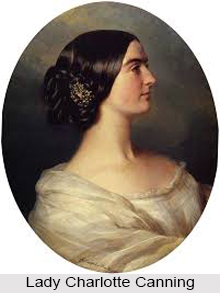 Charlotte Canning, who is also noted as Countess Canning in British East India Company"s historical document was known as the most interesting character of that time. She was famous as the artist and painter of that era. Her tomb is in Barrackpore of West Bengal and the cenotaph is now in the complex of St. John"s Church, Kolkata, West Bengal.
Charlotte Canning, who is also noted as Countess Canning in British East India Company"s historical document was known as the most interesting character of that time. She was famous as the artist and painter of that era. Her tomb is in Barrackpore of West Bengal and the cenotaph is now in the complex of St. John"s Church, Kolkata, West Bengal.
Early Life of Charlotte Canning
Charlotte Canning was born on 31st March 1817. The two portfolios in the Victoria and Albert Museum in London contain some three hundred and fifty watercolours by her, the result of four major tours in India. Charlotte Canning was born Charlotte Stuart in Paris, a daughter of the British Ambassador, Charles Stuart (later Baron Stuart de Rothesay) and was a Lady of the Bedchamber to Queen Victoria from 1842 to 1855.
Charlotte Canning"s Arrival in India
Charlotte Canning, who is also noted as Countess Canning arrived in India in the year 1856 as a flourishing, healthy woman when her husband was appointed Governor-General of India. She went with him to Calcutta (Kolkata, West Bengal). She kept a journal and wrote frequently to Queen Victoria, at one point describing strange and terrible outbreaks of violence which were the start of the Indian Mutiny in 1857. In 1859 Charles Canning was raised in the peerage as Earl Canning and Charlotte became Countess Canning.
Death of Charlotte Canning
The health of Charlotte Canning deteriorated in 1861 and she died of malaria in her husband`s arms. She was buried in Barrackpore, West Bengal. Lord Canning did not long outlive her; his letter to Victoria describing her death crossed with the Queen`s to him, announcing that Prince Albert had died. Lady Canning`s name lives on in Bengal where a type of sweet called ledikeni is named after her. Her grave and memorial seems to have been moved some time since 2005 and is now located adjacent to St John`s Church in Kolkata.
Personal Life of Charlotte Canning
On 5th September 1835, Charlotte Canning married Charles Canning a son of the former British Prime Minister, George Canning and the 1st Viscountess Canning. In 1837 Charles Canning succeeded to his mother`s title as Viscount Canning, whereupon Charlotte became Viscountess Canning.



















